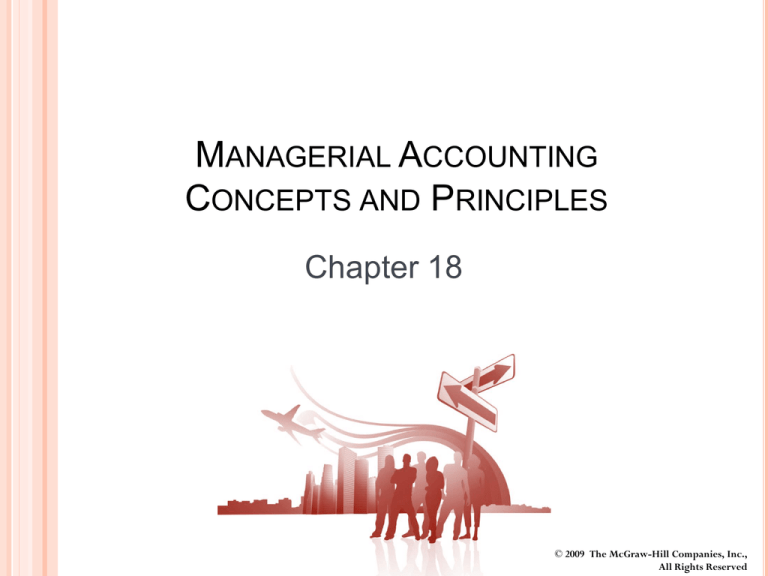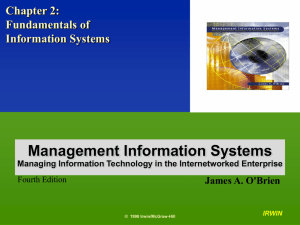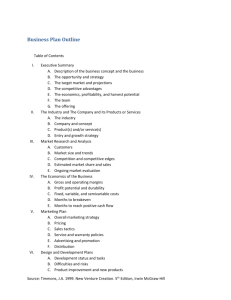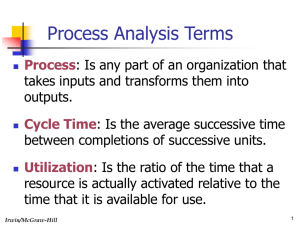
MANAGERIAL ACCOUNTING
CONCEPTS AND PRINCIPLES
Chapter 18
© 2009 The McGraw-Hill Companies, Inc.,
All Rights Reserved
C1
PURPOSE OF MANAGERIAL ACCOUNTING
McGraw-Hill/Irwin
Slide 2
C1
NATURE OF MANAGERIAL ACCOUNTING
Exh.
18-2
Financial Accounting
Managerial Accounting
Investors, creditors and
other external users
Managers, employees and
other internal users
2. Purpose of
information
Making investment, credit
and other decisions
Planning and
control decisions
3. Flexibility
of practice
Structured and often
controlled by GAAP
Relatively flexible
(no GAAP)
4. Timeliness of
information
Often available only
after audit is complete
Available quickly without
need to wait for audit
5. Time dimension
Historical information
with some predictions
Many projections
and estimates
6. Focus of
information
Emphasis on
whole organization
Projects, processes and
segments of an organization
7. Nature of
information
Monetary
information
Monetary and
nonmonetary information
1. Users and
decision makers
McGraw-Hill/Irwin
Slide 3
C2
MANAGERIAL ACCOUNTING IN BUSINESS
Lean Business Model
Customer
Orientation
Global
Economy
Lean
Business
Model
Elimination
of Waste
McGraw-Hill/Irwin
Satisfy the
Customer
Positive
Return
Slide 4
C2
LEAN PRACTICES
Customer
Orientation
in a Global
Economy
McGraw-Hill/Irwin
Slide 5
FRAUD AND ETHICS IN
MANAGERIAL ACCOUNTING
C3
Fraud involves the use of one’s job for personal gain through the
deliberate misuse of the employer’s assets. There are many types
of fraud, but common characteristics of all fraud are that it:
• Is done to provide direct or indirect benefit to the employee.
• Violates the employees’ duties to his employer.
• Costs the employer money.
• Is secret.
Fraud increases business costs. Management relies on internal
control systems to monitor business activities and on accounting
systems to track costs and identify unexpected amounts.
Ethics are beliefs that distinguish right from wrong. They are
accepted standards of good and bad behavior. The Institute of
Management Accountants has issued a code of ethics to help
accountants involved in solving ethical dilemmas.
McGraw-Hill/Irwin
Slide 6
TYPES OF COST CLASSIFICATIONS
CLASSIFICATION BY BEHAVIOR
Cost behavior refers to
how a cost will react to
changes in the level of
business activity.
Cost
C4
• Total fixed costs do
not change when
activity changes.
Cost
Activity
• Total variable costs
change in proportion
to activity changes.
Activity
Cost
• Mixed costs are
combinations of fixed
and variable costs.
McGraw-Hill/Irwin
Activity
Slide 7
TYPES OF COST CLASSIFICATIONS
CLASSIFICATION BY TRACEABILITY
C4
Direct costs
Costs traceable to a
single cost object.
Examples: material
and labor cost for a
product.
McGraw-Hill/Irwin
Indirect costs
Costs that cannot
be traced to a
single cost object.
Example: A
maintenance
expenditure
benefiting two or
more departments.
Slide 8
TYPES OF COST CLASSIFICATIONS
CLASSIFICATION BY RELEVANCE
C4
Sunk costs have already been incurred and cannot be avoided
or changed. Sunk costs should not be considered in decisions.
Example: An automobile purchased two years ago cost $15,000.
The $15,000 cost is sunk because whether the car is driven, sold,
traded, or abandoned, the cost will not change.
Out-of-pocket costs require future outlays of cash.
Out-of-pocket costs should be considered in decisions.
Example: You plan on buying a new car for $25,000 next month.
The cost of the new car is an out-of-pocket cost because you can
choose to spend or not to spend the $25,000 next month.
McGraw-Hill/Irwin
Slide 9
TYPES OF COST CLASSIFICATIONS
CLASSIFICATION BY RELEVANCE
C4
An opportunity cost is the potential benefit lost by choosing
a specific action from two or more alternatives
Example: If you were not attending college, you could be
earning $20,000 per year. Your opportunity cost of
attending college for one year is $20,000.
McGraw-Hill/Irwin
Slide 10
TYPES OF COST CLASSIFICATIONS
CLASSIFICATION BY FUNCTION
C5
Direct
Labor
Direct
Material
Manufacturing
Overhead
Product
Period costs are expenses
not attached to the product.
Selling costs are incurred to
obtain orders and to deliver
finished goods to customers.
McGraw-Hill/Irwin
Administrative costs are
non-manufacturing costs
of staff support and
administrative functions.
Slide 11
C5
PERIOD AND PRODUCT COSTS
IN FINANCIAL STATEMENTS
Period Costs
(Expenses)
2009 Income
Statement
Operating
Expenses
2009 Costs
Incurred
Cost of
Goods Sold
Inventory
Sold in 2009
Product Costs
(Inventory)
Inventory Not
Sold in 2009
McGraw-Hill/Irwin
2010 Balance
Sheet Inventory
Raw Materials
Goods in Process
Finished Goods
Exh.
18-8
2010 Income
Statement
Cost of
Goods Sold
Slide 12
MANUFACTURER’S BALANCE SHEET
C6
Raw
Materials
Goods in
Process
Finished
Goods
Materials
waiting to be
processed.
Partially complete
products.
Completed
products
for sale.
Can be direct
or indirect.
Material to which
some labor and/or
overhead have
been added.
McGraw-Hill/Irwin
Slide 13
C6
MANUFACTURER’S INCOME STATEMENT
Exh.
18-11
Merchandiser
Manufacturer
Beginning
Merchandise
Inventory
Beginning
Finished Goods
Inventory
+
+
Cost of Goods
Purchased
_
The major
difference
Ending
Merchandise
Inventory
=
McGraw-Hill/Irwin
Cost of Goods
Manufactured
_
Ending
Finished Goods
Inventory
Cost of Goods
Sold
=
Slide 14
ACTIVITIES AND COST FLOWS
IN MANUFACTURING
C7
Exh.
18-15
Materials
activity
Production activity
Sales activity
Raw
Materials
Beginning
Inventory
Goods in Process
Finished Goods
Raw
Materials
Purchases
Factory
Overhead
McGraw-Hill/Irwin
Beginning Inventory
Beginning Inventory
Direct Labor
Cost of Goods
Manufactured
Raw Materials
Used
Finished
Goods
Ending
Inventory
Raw Materials
Goods in Process
Ending Inventory
Ending Inventory
Cost
of
Goods
Sold
Slide 15
CYCLE TIME AND CYCLE
EFFICIENCY
A1
Order
Received
Wait Time
Production
Started
Goods
Shipped
Process Time + Inspection Time
+ Move Time + Queue Time
Manufacturing Cycle Time
Total Cycle Time
Manufacturing
Cycle
=
Efficiency
McGraw-Hill/Irwin
Value-added time
Manufacturing cycle time
Slide 16
END OF CHAPTER 18
McGraw-Hill/Irwin
Slide 17






